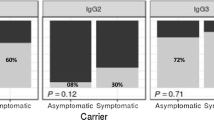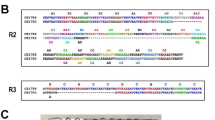Abstract
Subclasses of antibodies to the C-terminal 19 kDa fragment of the Plasmodium vivax merozoite surface protein 1 (PvMSP-119) were assessed among subjects with distinct degrees of malaria exposure in the Brazilian endemic area. The PvMSP-119 specific IgG1and IgG3 levels were low among subjects with long-term exposure (~19 years) when compared to subjects less and sporadically exposed (<1 year). No statistically difference was observed in IgG subclass distribution of antibodies from symptomatic Plasmodium-infected patients, asymptomatic parasite carriers and non-infected subjects living in a same mesoendemic area. Subjects briefly exposed to a P. vivax outbreak living in a rural community outside the endemic area were also evaluated to measure the persistence of specific antibodies. IgG anti-PvMSP-119 antibodies persisted in 40% of the subjects who had had malarial symptoms 8 months before and decreased after 7 years (28%). Specific IgG1 were the predominant isotype. Our study emphasizes the highly immunogenicity of the PvMSP-119 and points toward its possible use as a potential malaria vaccine.




Similar content being viewed by others
References
Blackman MJ, Heidrich H, Donachie S, Mcbride JS, Holder AA (1990) A single fragment of a malaria merozoite surface protein remains on the parasite during red cell invasion and is the target of invasion-inhibiting antibodies. J Exp Med 172:379–382
Blackman MJ, Ling IT, Nicholls SC, Holder AA (1991) Proteolytic processing of the Plasmodium falciparum merozoite surface protein-1 produces a membrane-bound fragment containing two epidermal growth factor-like domains. Mol Biochem Parasitol 49:29–33
Braga EM, Fontes CJF, Krettli AU (1998) Persistence of humoral response against sporozoite and blood-stage malaria antigens 7 years after a brief exposure to Plasmodium vivax. J Infect Dis 177:1132–1135
Braga EM, Barros RM, Reis TA, Fontes CJF, Morais CG, Martins MS, Krettli AU (2002) Association of the IgG response to Plasmodium falciparum merozoite protein (C-terminal 19 kD) with clinical immunity to malaria in the Brazilian Amazon region. Am J Trop Med Hyg 66:461–466
Branch OH, Oloo AJ, Nahlen BL, Kaslow D, Lal AA (2000) Anti-merozoite surface protein-1 19-kDa IgG in mother-infant pairs naturally exposed to Plasmodium falciparum: subclass analysis with age, exposure to asexual parasitemia, and protection against malaria. V. The Asembo Bay cohort project. J Infect Dis 181:1746–1752
Cunha MG, Rodrigues MM, Soares IS (2001) Comparison of the immunogenic properties of recombinant proteins representing the Plasmodium vivax vaccine candidate MSP119 expressed in distinct bacterial vectors. Vaccine 20:385–396
Dekker C, Uthaipibull C, Calder LJ, Lock M, Grainger M, Morgan WD, Dodson GG, Holder AA (2004) Inhibitory and neutral antibodies to Plasmodium falciparum MSP119 form ring structures with their antigen. Mol Biochem Parasitol 137:143–149
Dodoo D, Theander TG, Kurtzhals JA, Koram K, Riley E, Akanmori BD, Nkrumah FK, Hviid L (1999) Levels of antibody to conserved parts of Plasmodium falciparum merozoite surface protein 1 in Ghanaian children are not associated with protection from clinical malaria. Infect Immun 67:2131–2137
Egan AE, Morris J, Barnish G, Allen S, Greenwood BM, Kaslow DC, Holder A, Riley EM (1996) Clinical immunity P. falciparum malaria is associated with serum antibodies to the 19 kDa C-terminal fragment of the merozoite surface antigen PfMSP1. J Infect Dis 173:765–769
Engers HD, Godal T (1998) Malaria vaccine development: current status. Parasitol Today 14:56–64
Fontes CJF (2001) Malária assintomática em áreas de garimpo no Brasil: estudos de fatores de risco. Belo Horizonte: Faculdade de Medicina da Universidade Federal de Minas Gerais. Belo Horizonte, PhD Thesis, p 178
Fontes CJF, Bathurst I, Krettli AU (1991) Plasmodium vivax sporozoite antibodies in individuals exposed during a single malaria outbreak in a non-endemic area. Am J Trop Med Hyg 44:28–33
Fraser T, Michon P, Barnwell JW, Noe AR, Al-Yaman F, Kaslow DC, Adams JH (1997) Expression and serologic activity of a soluble recombinant Plasmodium vivax Duffy binding protein. Infect Immun 65:2772–2777
Han HJ, Park SG, Kim SH, Hwang SY, Han J, Traicoff J, Kho WG, Chung JY (2004) Epidermal growth factor-like motifs 1 and 2 of Plasmodium vivax merozoite surface protein 1 are critical domains in erythrocyte invasion. Biochem Biophys Res Commun 320:563–570
Holder AA (1988) The precursor to major merozoite surface antigens: structure and role in immunity. Prog Allergy 41:72–97
Holder AA, Guevara Patino JA, Uthaipibull C, Syed SE, Ling IT, Scott-Finnigan T, Blackman MJ (1999) Merozoite surface protein 1, immune evasion, and vaccines against asexual blood stage malaria. Parassitologia 41:409–414
Lim KJ, Park JW, Yeom JS, Lee YH, Yoo SB, Oh JH, Sohn MJ, Bahk YY, Kim YS (2004) Humoral responses against the C-terminal region of merozoite surface protein 1 can be remembered for more than 30 years in persons exposed to Plasmodium vivax. Parasitol Res 92:384–389
Marques AC (1987) Human migration and the spread of malaria in Brazil. Parasitol Today 3:166–170
O’Donnell RA, De Koning-Ward TF, Burt RA, Bockarie M, Reeder JC, Cowman AF, Crabb BS (2001) Antibodies against merozoite surface protein MSP-119 are a major component of the invasion-inhibitory response in individuals immune to malaria. J Exp Med 193:1403–1412
Parish CR (1972) The relationship between humoral and cell-mediated immunity. Transplant Rev 13:35–66
Park JW, Moon SH, Yeom JS, Lim KJ, Sohn MJ, Jung WC, Cho YJ, Jeon KW, Ju W, Ki CS, Oh MD, Che KW (2001) Naturally acquired antibody responses to the C-terminal region of the merozoite surface protein 1 of Plasmodium vivax in Korea. Clin Diagn Lab Immunol 8:14–20
Pasay MC, Cheng Q, Rzepczyk C, Saul A (1995) Dimorphism of the C terminus of the Plasmodium vivax merozoite surface protein 1. Mol Biochem Parasitol 70:217–219
Riley EM, Wagner GE, Ofori MF, Wheeler JG, Akanmori BD, Tetteh K, McGuinness D, Bennett S, Nkrumah FK, Anders RF, Koram KA (2000) Lack of association between maternal antibody and protection of African infants from malaria infection. Infect Immun 68:5856–5863
Sawyer D (1993) Economic and social consequences of malaria in new colonization projects in Brazil. Soc Sci Med 37:1131–1136
Scopel KKG, Fontes CJF, Nunes AC, Horta MF, Braga EM (2004) Low sensitivity of nested PCR using Plasmodium DNA extracted from stained thick blood smears: an epidemiological retrospective study among subjects with low parasitemias in a Brazilian Amazon endemic area. Malar J 3:8
Soares IS, Levitus G, Souza JM, Del Portillo HA, Rodrigues MM (1997) Acquired immune responses to the N- and C-terminal regions of P. vivax merozoite surface protein 1 in individuals exposed to malaria. Infect Immun 65:1606–1614
Soares IS, Oliveira SG, Souza JM, Rodrigues MM (1999a) Antibody response to the N- and C-terminal regions of the Merozoite surface protein 1 in individuals living in an area of exclusive transmission of Plasmodium vivax malaria in the north of Brazil. Acta Trop 72:13–24
Soares IS, Cunha MG, Silva MN, Souza JM, Del Portillo HA, Rodrigues MM (1999b) Longevity of the naturally acquired antibody responses to the N- and C-terminal regions of P. vivax MSP1. Am J Trop Med Hyg 60:357–363
Soares IS, Barnwell JW, Ferreira MU, Cunha MG, Laurino JP, Castilho BA, Rodrigues MM (1999c) A Plasmodium vivax vaccine candidate displays limited allele polymorphism, which does not restrict recognition by antibodies. Mol Med 5:459–470
Taylor-Robinson AW (1998) Immunoregulation of malarial infection: balancing the vices and virtues. Int J Parasitol 28:135–148
Acknowledgments
This work was financially supported by Fundação de Amparo à Pesquisa do Estado de Minas Gerais FAPEMIG (grant no. CBB2323/97). Informed consent was obtained from subjects according to the Universidade Federal de Minas Gerais Ethics Committee (15 April 1998) and Fundação Oswaldo Cruz Ethics Committee (26 November 1994).
Author information
Authors and Affiliations
Corresponding author
Rights and permissions
About this article
Cite this article
Morais, C.G., Soares, I.S., Carvalho, L.H. et al. IgG isotype to C-terminal 19 kDa of Plasmodium vivax merozoite surface protein 1 among subjects with different levels of exposure to malaria in Brazil. Parasitol Res 95, 420–426 (2005). https://doi.org/10.1007/s00436-005-1314-x
Received:
Accepted:
Published:
Issue Date:
DOI: https://doi.org/10.1007/s00436-005-1314-x




